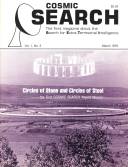![[NAAPO Logo]](../../Images/NAAPOsm.jpg) North American AstroPhysical Observatory (NAAPO)
|
|
Editorial "Let's Get SETI Through Congress"
By: Bernard M. Oliver
The NASA FY '79 Budget included $2 million for the first year of a 5 year SETI program with a total budget of $20 million. This program had the approval of the President's Science Advisor, of the OMB, and of the House and Senate authorization committees. Yet the House and Senate appropriations committees eliminated it entirely.
In times when reductions in government spending are being sought, the temptation to turn down any new program, regardless of its merits, is very strong. But such a procedure is short-sighted and ultimately dangerous. The way to prune a tree is to saw off old dead
branches and balance the remaining ones to please the eye, not to nip off every new young bud. The way to make real budget reductions is to cut out large and old programs that have proven to be ineffective or that have outlived their usefulness, and to balance the
remaining programs, not to practice infanticide. If we don't weed out the old and useless to make way for the new, we'll never get anywhere.
Because of bureaucratic entrenchment it is very difficult to discontinue existing programs. It takes real courage to stand up in Congress and say that a program is ineffective, that the jobs it provides are unproductive. But don't we have a right to expect
courage in our representatives?
SETI has enormous popular appeal. Its inclusion as a NASA program would be hailed by the voting taxpaying public who, in general, care little about the scientific discoveries space has produced, but who are enormously interested in the prospect of other intelligent life. Unscientific motion pictures and fraudulent books about extraterrestrial life enjoy unprecedented popularity today. Surely a soundly based, scientific program would be accepted. In fact, most laymen assume that a SETI program is already going on. Isn't it time NASA lived up to this popular belief?
SETI has withstood two decades of scientific scrutiny. Each passing year finds scientists more convinced of the abundance of life in the universe, and engineers more pessimistic about the possibility of economically feasible interstellar travel. The only practical way to discover this other intelligent life is to search for radio (or other) signals it radiates. Existing radio telescopes could detect their counterparts anywhere in the Galaxy, but this will never happen unless we search in a systematic way. It is important
that we begin now while there are empty bands in the microwave spectrum where we can listen without man-made interference. If we do not pre-empt some of these windows for SETI we will forever blind ourselves to the mainstream of life and end up as Galactic
recluses.
The real problem may be that our Senators and Congressmen need a little SETI fan mail. People tend to write their representatives to condemn rather than to support, and SETI no doubt has elicited letters of condemnation and derision. Would you help tip the scales the other way? Tell your Congressmen and Senators that you'd be happy if one dollar of your taxes annually went to SETI. Think what a magnificent search program $50 million per year would support!
|
